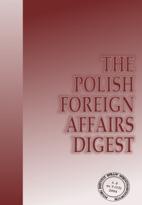

Keywords: Romania; Eminescu; political philosophy; State; social contract; Schopenhauer;
Part of Eminescu’s political thought still needs to be elucidated. In this paper, I strongly qualify the (received) opposition between his theory of ”the natural State” and the concept of ”the social contract”, which he rejects. While Eminescu does not subscribe to the contract’s democratic and liberal premises, the notion of ”a social pact” – if not the word itself – is definitely one he resorts to when expounding his theory of the ”social compensation”. He combines recent theoretical developments in economy with philosophical theories taken from the works of Spinoza, Locke, Rousseau, and last but not least, Schopenhauer. A comparative reading of his writings shows that Eminescu borrows whole passages from the German philosopher, whose influence on Eminescu's political philosophy should be strongly reassessed. The metaphysics of ”the will to live” provided him with the foundation for his own original version of the social pact which he developed within the evolutionary framework of Junimea, after Maiorescu encouraged him to move in this direction.
More...
The notion of the “observer” is a basic modeling metaphor of the modernist age. It has different meanings within different cultural frames: “observation” as a scientific procedure; a model of behavior (Crary 2000: 29); a model of perception; the cognitive function of discourse, etc. The issue of the “observer” is part of a broader set of epistemological problems, which become central in relativist physics, Gestalt psychology, and the theory and practice of art and fiction. That is: how separate observations are related to the general system of knowledge and whether such an integrated system of knowledge exists at all if observation influences and shapes the observable. The crisis of the Cartesian subject entails a necessity of permanent reflexion on the observer’s relation to the world (see e.g. Yampolsky 2000)
More...
Keywords: artistic value; ethics; moral value; values of art
The principal focus of the essay is the idea of artistic value, understood as the value of a work of art as the work of art it is, and the essay explores the connections, if any, between artistic value and a variety of other values (social, moral, educational, and character-building) in human life. I start with a series of observations about social values and then turn to moral values. Beginning from Goethe’s claim that ‘music cannot affect morality, nor can the other arts, and it would be wrong to expect them to do so’, I proceed from music through the other arts; I distinguish different conceptions of morality; I highlight what I call a work of art’s positive moral value (its power for moral improvement); and distinguish three kinds of moral improvement, one taking pride of place. My conclusion is that the positive moral value of works of art has been greatly overrated. I then return to the social values of art, looking at the situation from a very different point of view and reaching new conclusions, some of them positive. I end by explaining why my observations and arguments about the positive moral value of a work of art in no way diminishes the importance of art in human life, the true end of art having an importance in human life not guaranteed by morality.
More...
Keywords: Čapek J.; primitivism; ethnic art; modernism
Josef Čapek’s writings from between 1914 and 1920 present a distinctive conception of primitivism, which was, beginning in the early twentieth century, of fundamental importance for the development of modern trends in the fine arts, in connection with the essential change in understanding the term ‘art’. Two manuscript version of the essay Umění přírodních národů (The art of primitive peoples) from 1914 to 1916 and the article ‘Sochařství černochů’ (Negro sculpture) from 1918 are amongst the first European critical attempts to interpret ethnic art. Čapek presents the ‘art of the savages’ (divošské umění) as fully fledged art, and he tries to analyse its principles of expression. He compares them to current trends in art. The essays from the volume Nejskromnější umění (The humblest art, 1919–20), which consider other dimensions of primitivism, present a particular definition and expansion of the term ‘art’. In contrast to academic virtuosity, Čapek here emphasizes values of hitherto peripheral and unacknowledged areas of artistic expression, and achieves a distinctively personal revision of the traditional conception of the boundaries of the work of art and therefore also its essence and purpose. The essay ‘Sociální užitečnost umění’ (The social utility of art, 1919) also relates to these questions.
More...This paper focuses on the ways in which national identities are staged in recent film and theatre productions in Estonia. We want to complement the prevalent approaches to nationality (Anderson 1983; Gellner 1983; Bhabha 1990), where the role of theatre and film as modellers of national identity are undervalued. National identity is a complex term that presupposes some clarification, which we gave by describing its dynamics today; its relation to ethnic identity, a thread between the lived and declared national identities, and the relevance of culture-based national identity. Herein we consider the concept of staging to have two implications: (1) as an aesthetic term it incorporates an artistic process, comprising several devices and levels; (2) as a concept in cultural theory it describes cultural processes in which something is set on stage for public reflection. Accordingly, in our analysis we considered national identities in theatre and film stagings in both senses. The results of our analyses demonstrated that our hypothesis about emerging new national identities in Estonia was valid, though deconstructed and hybrid national identities are not exactly and absolutely new types of identities but rather strategies of creating space for new identities to develop. A deconstructed national identity refers to the state of high self-reflexivity in which the existing elements of national identity are re-examined, recontextualised and re-evaluated. Further, a hybrid national identity demonstrates the diversity and coexistence of the components of national identity. Both strategies of staging are characteristic of the transformation of national identities, confirming that a single homogenous staging of national identity seems to be replaced by bringing multiple new self-models on stage.
More...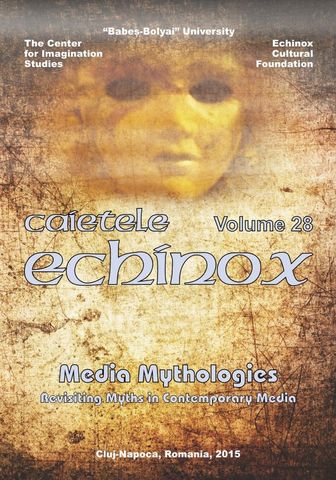
Keywords: Bible Epics; Hollywood Noah; Moses; Cinema Narratives; Myth in Cinema; Meme Mutation; Cultural Revision; Mongrelized Mythologies.
This paper discusses the mythological shift generated by the process of cultural infantilization, using two recent feature films, based on two of the most important Biblical characters, Noah and Moses. These movies, labeled as forms of “Hollywood heresy”, Zionist distortions or even anti-Christian deceptions are analyzed in the context of the transformation in the representations of God (and the prophets) in contemporary culture, which is seen by the author as part of a mutation in the “genome of the God meme”. Starting with the hypothesis of a “third Golden Age of the Biblical Epic” the authors advances the concept of meme mutation, considering that a most recent “mind virus” is rapidly multiply in our popular culture, through a process that can be called the versatile revision of narratives, one perpetuated by deception and distortion, in a viral propagation that accelerates certain meme replications. The hypothesis is that we are facing a defective cultural mutation one in which, by transfer of qualities, the visual and ideological representations are carrying parasitic manifestations, malignant traits which are in turn perpetuated in our contemporary mongrelized mythological replication. This study is based on the interpretation of two different forms of cinematic interpretations of myths in recent movie making: exegetic and eisegetic. These two approaches to mythological re-writing in cinema are also identifiable with oversimplification and overcomplication of narratives.
More...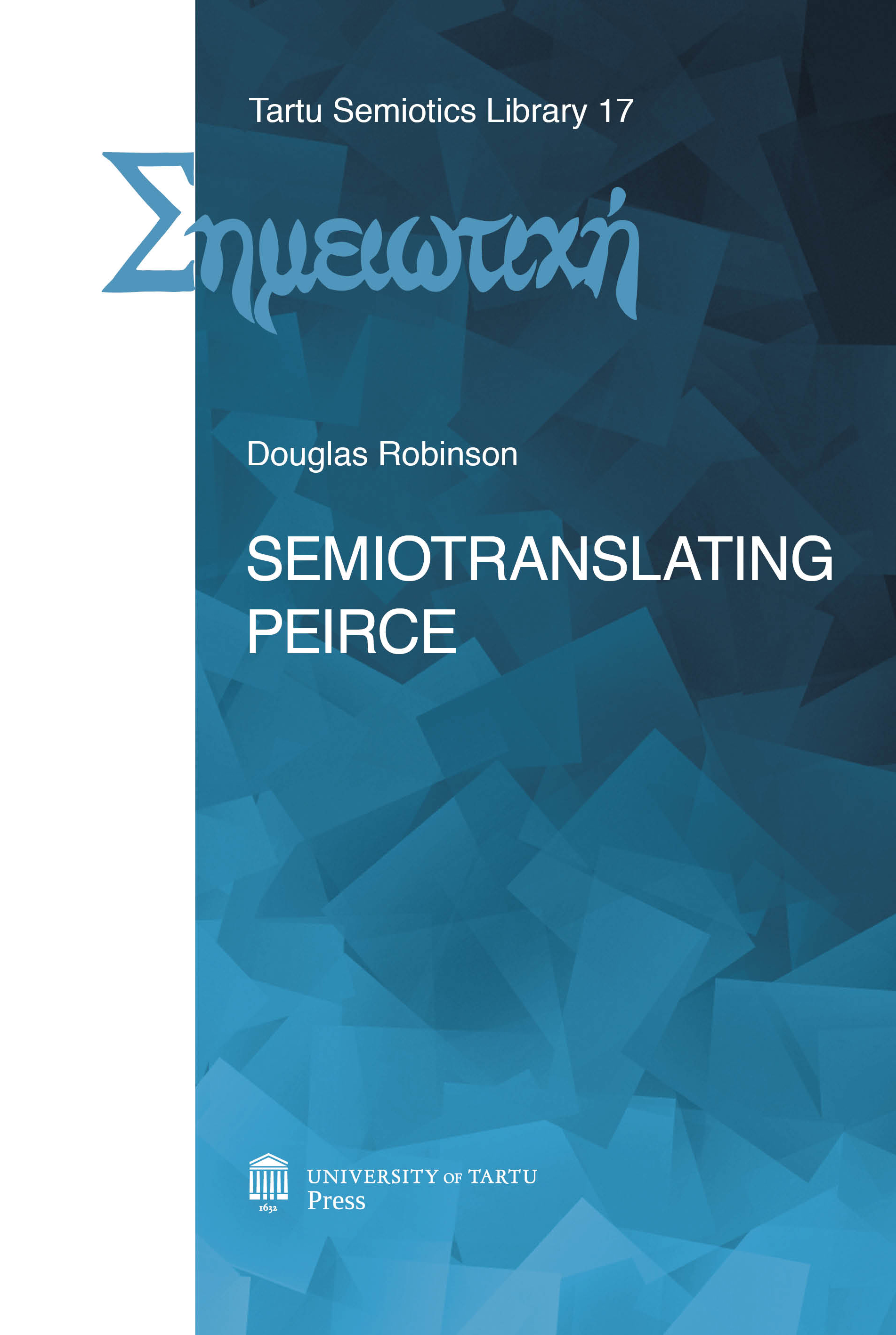
Still, the possibility of an instinct-experience-habit triad is not exactly alien to Peircean thought: add to the instinct-experience-form triad the passage from the late essay “A Neglected Argument for the Reality of God” (CP 6.454), where “An ‘Experience’ is a brutally produced conscious eff ect that contributes to a habit,” and the 1902 “Minute Logic,” where he defines an “instinct” as an “an inherited habit” (CP 2.170), thus bending the triad around into a cycle.
More...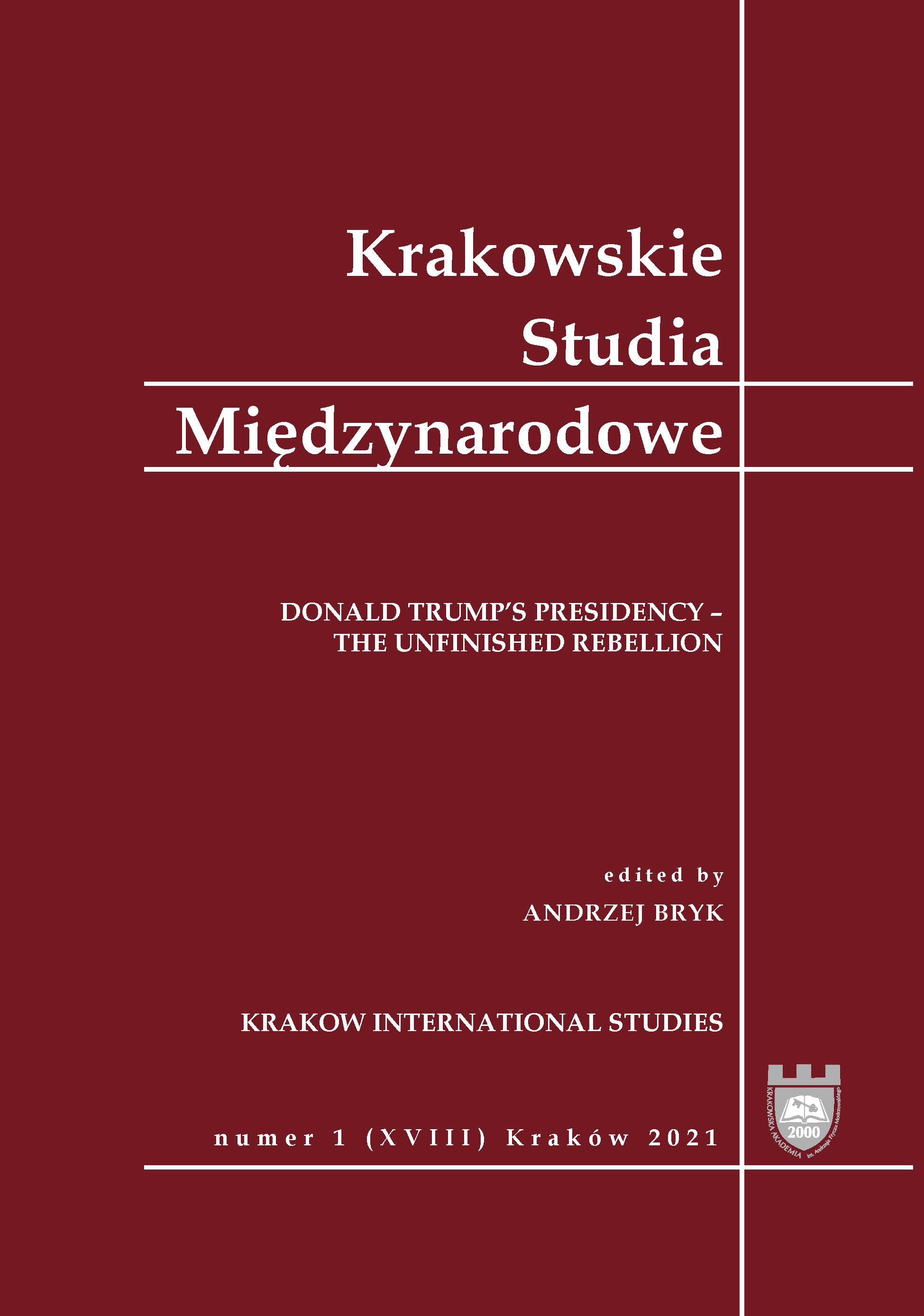
Keywords: Donald Trump’s Presidency; American Conservatism; liberal oligarchy; populism; identity liberalism; fragmentation of American socjety;
Donald Trump became the president of the United States because he was able to see the deep division of the American society into 80% of the population comprising the lower and middle classes and the caste-like oligarchic elite, which is made up of the richest 1% and 19% of the upper-middle class population. These 20% justifies its privileged social position by referring to meritocracy, the ideology of identity liberalism and to globalism, delegitimizing any opposition as a manifestation of ignorance, pathological aggression or social maladjustment (“the deplorables” of Hillary Clinton). Trump turned to the remaining 80% of society, angered not only by the effects of globalization implemented by the liberal elites as the only possible and rational economic policy, but also despised by the liberal upper middle class and forced by political elites to submit to the dictates of the ideology of emancipatory liberalism of personal autocreation, leading to the breakdown of social and family ties and the destruction of authorities. Trump won the support of angry voters because he raised issues that were very close to much of the electorate but were absent from the dominant discourse of political elites, both in the Democratic Party and the Republicans. This was his “populism”, which was in fact democratic and conservative patriotism or mild nationalism. Nevertheless, this provoked vehement opposition from both the liberal left, part of the federal administration (“deep state”) and cancel culture, and from some republicans (“Never Trumpers”). However, the “resistance movement” that emerged after Trump’s election was able to appeal only to ideological arguments, including the perception of America’s and the West’s civilizational heritage as a structure of immanent oppression that Trump wants to renew and strengthen. Thus, a narrative was born presenting Trump as a usurper in a metaphysical sense, an enemy of the only legitimate moral and social order, i.e., the order of identity liberalism with its axioms of emancipation and moral autocreation of individuals. The violation of this quasi-religious order is to cause an escalation of violence and oppression motivated by hatred, racism, xenophobia and religious fanaticism. Such a narrative, referring to the theory of the “end of history” by Francis Fukuyama, was not confirmed either in the politics or in the legislation of the Trump administration, demonstrating flaws in the liberal-left understanding of the so called “populism”.
More...
Keywords: Antihero; Episodic Television Drama; Superhero; The Boys; Society of Performance;
In this study, we would like to address the issue of antiheroism in relation to the popular episodic television drama The Boys (Amazon Prime Video, since 2019). The television antiherois discussed quite frequently, but more often in a rather general manner than based on specific case studies. The study outlines the related terminological axis and then applies the individual theoretical frameworks to a specific episodic television drama that presents an axiologically and morally determined conflict between fictional characters of superheroines and superheroes and their counterparts, ordinary citizens, direct or indirect victims of amoral decisions made by people with superhuman abilities. As we believe, applying the given body of knowledge to the selected television drama via a case study allows us to explain the contemporary understanding of antiheroism in relation to fictional characters with superhuman abilities and, at the same time, outline the specific aspects of so-called society of performance on basis of theoretical reflection on the issue, followed by a qualitative content analysis of the episodic television drama The Boys focused on its selected narrative and discursive aspects.
More...Keywords: ecology; sacrament; logos; matter; creation; cosmic Liturgy;
In the last decades, Christian theology has been accused of contributing indirectly to the ecological crisis due to its vision upon the natural world. This vision includes an exaggerated anthropocentrism, an affirmation of an almost absolute transcendence of God in relationship with the creation and an accent almost exclusive on the spiritual life, ignoring its materiality. Some Orthodox theologians argue that the theology of the Eastern Church cannot fit in this caricature of the Western theology. In the frame of this article I try to bring to forefront their contribution to promote a vision that integrates all the aspects of reality: spirit and matter, creation and Creator, human being, animated beings and unanimated things. The lessons of Orthodox theology aim at restoring the lost unity of things at all levels: mystically, sacramentally and educationally. They are the contribution of the Orthodox thinking to heal the ecological crisis.
More...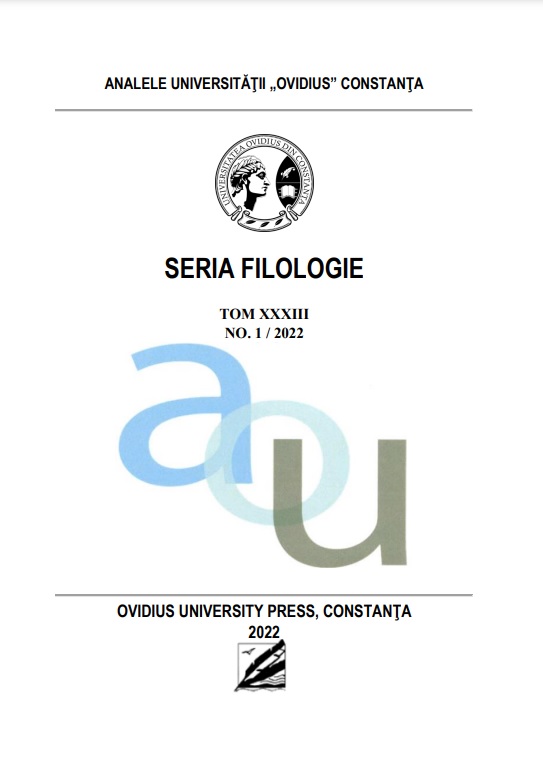
Keywords: adventure; 18th century; Enlightment; paraliterature; hedonism; aristocracy; arriviste; happiness;
This article analyzes the theme of adventure as it is developed in Mateiu I. Caragiale’s novel Gallants of the Old Court (Craii de Curtea-Veche). I am particularly interested in the way in which Mateiu I. Caragiale presents a pattern of adventure as it emerges from the culture and civilization of the 18th century and in particular of the Enlightenment, and a typology of the adventurer. Based on the distinction that Vladimir Jankélévitch makes in L’aventure, l'Ennui, le Sérieux between “adventurer” (l’aventurier) and “adventurous” (l’aventureux), I study the way Mateiu I. Caragiale adapts the 18th -century model in the context of modernity where the adventurer turns into an arriviste. I analyze this new typology of modernity from the perspective offered by both Mateiu I. Caragiale’s novel and his correspondence with his young friend N.A. Boicescu, given that the pattern proposed by the author of Gallants of the Old Court represents a hybrid between the two typologies. I also explore how the reading of Félicien Champsaur’s novel The Arriviste influenced the Romanian prose writer and his way of conceiving his characters, and his lifestyle as well.
More...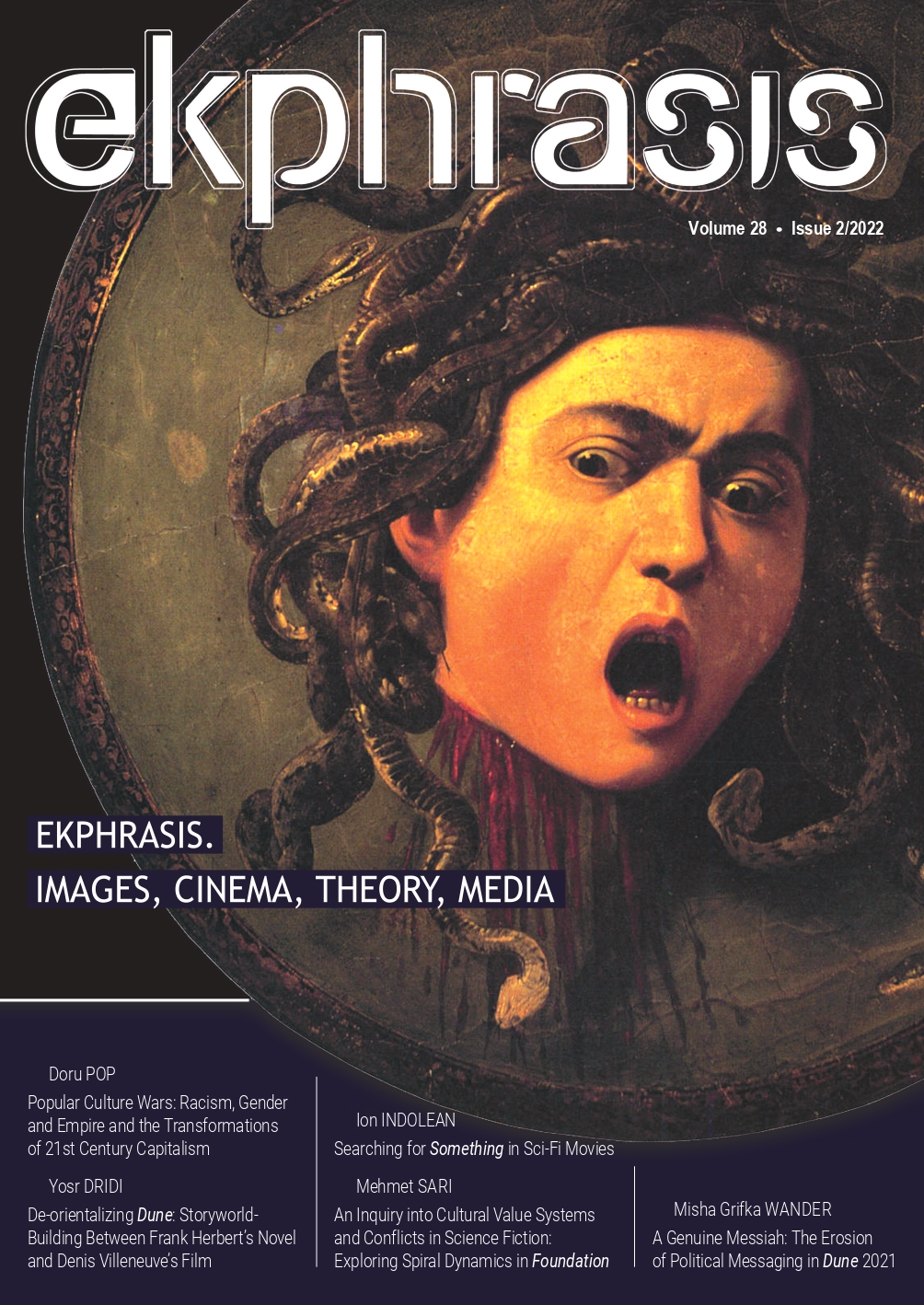
Keywords: Isaac Asimov; Foundation; Frank Herbert; Dune; capitalism; racial cinema; science fiction; racism; imperialism; chimeric cinema;
Isaac Asimov’s Foundation and Frank Herbert’s Dune were considered to be “unadaptable” works. This paper critically discusses Villeneuve’s Dune and the TV series created by AppleTV+, a revision of the “Foundation”, overviewing the controversies surrounding the recreation and transformation of these “grand narratives”. The author considers that these transmutations are relevant not only for their storytelling alterations, but also for the transformations of “cinematic capitalism”. Proposing as a working concept the notion of chimeric capitalist cinema, the paper also brings into the debate other productions that disclose ideological mutations, like Rings of Power and House of the Dragon, considering how contemporary cinematic modes of production are changing.
More...
Keywords: fake news; disinformation; economic security; banking sector; pandemic; COVID-19;
The purpose of the article is to discuss a new category of threat to the economic security of the state, which is the phenomenon of creation and dissemination of fake news. The analysis was conducted during a difficult period of coronavirus spread. This timing is particularly important as most countries around the world are experiencing negative economic impacts from the emergence of COVID-19. Economic systems, including Poland’s, are exposed to unprecedented challenges. This particular time may favor many state-level stakeholders or multinational corporations to weaken the Polish state. In the article the author analyzed fake news that appeared in the public space after 13 March 2020. Additionally, as a case study, he presented mechanisms developed in one of the institutions of the financial safety net in Poland.
More...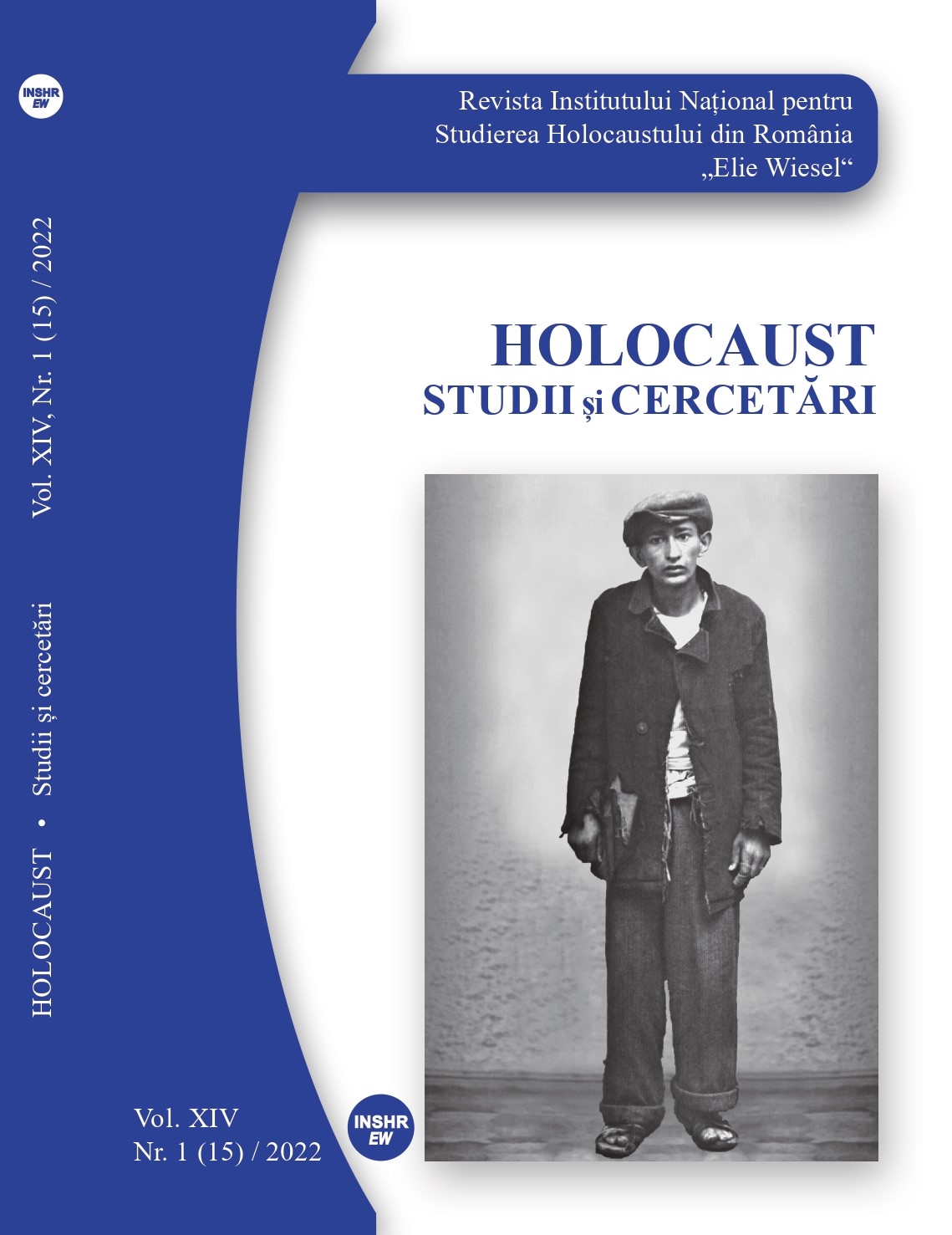
Keywords: calculated ambivalence; dog-whistle politics; doublespeak; antisemitism; Holocaust denial;
Romania has proved to be no outlier in the ongoing trend of mainstream-ization of far-right and neo-fascist politics and discourses, despite the optimistic outlook that many shared not long ago. AUR marked a historical success, being the first “radical return” political formation to gain seats in Parliament after 1989. As a result, a process of accelerated normalization of the far-right discourse is taking place, moving the political spectrum further to the (extreme) right, while also rehabilitating historical figures that played a significant role in the Holocaust. The present paper draws on Discourse Historical Analysis and concepts such as “calculated ambivalence” and “dog-whistle politics” to unpack the coded meanings and whistles entwined in the discursive provocations and reactions of AUR’s leader, George Simion. Starting from AUR’s press release from January 2022, minimizing the Holocaust, which set in motion the “right-wing populist perpetuum mobile”, I analyze the main discursive strategies, both confrontational and submissive, used by Simion in his effort to “dog-whistle” to AUR’s ultranationalist supporters, while at the same time denying allegations of antisemitism, Holocaust minimization, and fascist sympathies. For a qualitative measure of the success or failure of these strategies, a complementary critical analysis of the reactions of some of the most prominent antisemitic ultranationalist voices in Romania is carried out. Is Simion a skillful “dog-whistler” or a “traitor”? The study shows that there is a thin and fluid line between the two.
More...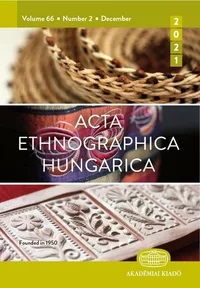
Keywords: national image; national dress; dress revival; court dress; dress code; dynastic image; dynastic propaganda; nationalism; multiethnic empire
Parallel with the emergence of modern national identity and culture, from the late 18th to the early 20th century an emphasized consciousness underlined the attempt to create a ‘national’ dress. In the court cultures of Europe, a shift in the style of representation from ‘international’ to ‘regional/ethnic’ and ‘national’ served the aim of updating the monarch's role. Royals reaffirmed their sense of belonging to their own ‒ or adopted ‒ nations through the conscious introduction of national elements into the dress code of the court. Royal courts also played a leading role in the myth-making process surrounding the so-called national style. The connection between power, prestige, and the dynamics of costume as a fashion statement is obvious in this process.
More...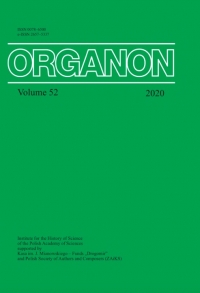
Keywords: cabinets of natural history; exotic plants; exotic raw materials; Podlasie; Anna Jabłonowska;
Lamarck and Cuvier built opposite theories concerning the origin of living beings, their links and fate. If they could agree on the bases of the animal classification, they drastically differed in their interpretations. Lamarck claimed the reality of the transformation of species, whereas Cuvier challenged and attacked him fiercely. The two naturalists competed strongly for the leading place in natural history at the beginning of the 19th century, dialoguing indirectly through their scientific papers, which need to be reviewed in light of this debate. Their polemical discussion shows some major issues in the emergent science of biology.
More...
Keywords: Tischner; Rogozhkin; evil; Communism; mystery;
The problem of evil is unavoidable and largely incomprehensible, and it is exactly for that reason that it is of great importance for our being. This aspect of Tischner’s philosophy can be successfully shown using the example of Andrei Srubov, the protagonist of The Chekist. By looking at Tischner’s agathology we receive hope that we are not doomed to be defeated by evil within our lifetime. What seems to be crucial in opposing evil is the realization that there is always a decision to be made.
More...
Keywords: Films by writers; propaganda; allegory; tragic humanism; evolutionary humanism;
This communication reviews some of the aesthetical and circumstantial characteristics of André Malraux’s only film, Sierra de Teruel (1939), also known as Espoir (Hope, 1945), and of Romain Gary’s first film, Les oiseaux vont mourir au Pérou (Birds in Peru, 1968). As regards Espoir, our observations are based on the 1939 and 1945 versions of the film, now of easy access, and on the abundant and reliable academic literature published about it. Birds in Peru, conversely, is a far lesser-known and lesser-documented work. Screenings of Gary’s film are all too rare indeed nowadays and, but for a few highly specialized references, its appraisal still consists in a short set of irrelevant legends, continually retold by biographers and academics alike despite their blatant discrepancies with historical evidence, with the film itself, and with Gary’s literary works in general. Ours are first-hand observations: in our possession is a release print, which we had digitized and can thus view at will. In addition, we have explored a variety of source materials in cinematographic archives and historical newspapers. Valued either as one of Malraux’s works or as an example of antifascist propaganda, it is lucky that Sierra de Teruel can still be viewed today, despite the political censorship that prevented its release in September 1939 and despite the destruction of all prints but two by the German occupant in France during WWII. Equally fortunate are the facts that moralistic considerations failed to stop the release of Birds in 1968 and that prints of it aren’t all lost. Gary scholars will find food for thought in it, as well as semioticians, Gary’s film being just as allegorical as his contemporary novel The Dance of Genghis Cohn. More generally still, both works, no naïve executions, bring evidence that talented writers can change media effectively. Far from being literal adaptations, their two films narrate free and inspired versions of stories already told in the written form. Their filming style is creative, their technique masterly. Their ease with the cinematographic medium allows them to reemploy and expand devices known to make their personal literary signature. Such as the striking juxtaposition of action and scenery used by Malraux to convey his metaphysics of disjunction between man and nature. Such as the subtle art of immigrating lexical components from other tongues and languages, idiosyncratic to Gary’s novel writing. Even elements of their respective forms of humanism show through their films.
More...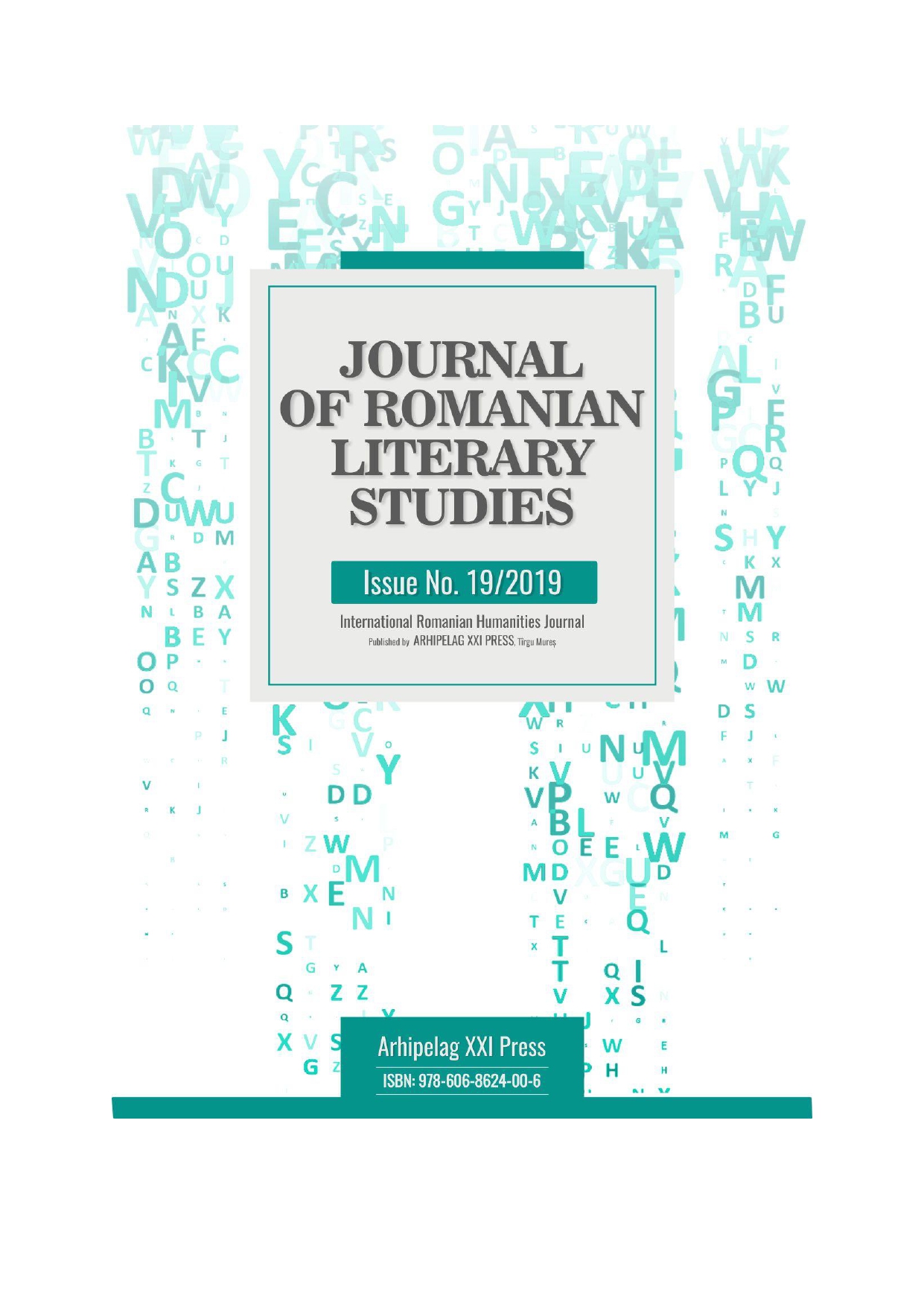
Keywords: poetry; context; generation; human condition; exuberance;
The sixties are defined by a pure lyricism that preceedes an era of a fixed belief that was lacking the ideal substance. The 1960-1971 period is one of revival because the Romanian literature is resetting through a throwback to the past, to the old values.Therefore the aestethic doctrine acts on the grounds of the party propaganda, the poetry harnesses the anthems through which Lenin and Gheorghe Gheorghiu-Dej were celebrated. On this background, writers like Maria Banus or Mihai Beniuc bring odes, venerate construction work or accuse the "nobility" who were then in prison suffering verz heavily. There autors that the party relied on such as Mihai Beniuc, Victor Tulbure, Ion Brad, Dan Desliu, Eugen Jebeleanu, Veronica Porumbacu, Demonstene Botez, Zaharia Stancu, Eugen Barbu, Radu Cosasu, Constantin Chirita and others.The modern poetry is vibrant, metaphors come back, the language is define through connotations. This relatively "ideological defrost", a collocation that is frequently met in the specialized literature unleashes the existing pressure, the language gets rid of the rigid aspect imposed by the previous period. The fictitional release from the oppresive force somehow remakes the interwar ballance, through the attempt of recovering the old values. The lyricism get aestethic vibration, it shapes through metaphors the images become unusual, feelings and vibrations are harnessed. The poetry get confessive accents, the attitude becomes playful and we are looking at the existential show. The road opener for the sixties generation was Nicolae Labis, even if he passed away in 1956. The "Labis" consists of the existence and harnessing the belief that says that our own thinking can be expressed freely. Thus the unchained expressing of the subjectivity and the free manner of writing place Nicolae Labis on top of the new generation situated under his works spectrum.A significant impact on the grounds of a relatively hostile climate relates to the appearance, in 1960of a poetry volume "Sensul iubirii" signed by Nichita Stanescu. The severe regime accepts the young Nichita Stanescu's vibration, who announces since 1957 his poetic message, intentionally metaphorised, without any political involvement, especially socialistic. The criticists of those times considered the poet's attitude to be a coded language that had obvious echoes in that ideological constrainted present.After 1971, even if the regime led by Nicolae Ceausescu tried to stop the creative explosion, the literature couldn't be completely controlled. The literary climate acknowledged Nichita Stanescu path opener, a valuable poet, beside whom there were the poets of the sixties generation. In fact altogether with the differences of the thematic or stylistic, we are wittnesses of a poetical revival that's synonimous with the lyrical exuberance.In 1960 the generation itself was prolific, was prosperous being similar to a metapoetic lyricism. The poetry of the sixties generation is heterogeneous, defined by reflexitivity, ambiguity, suggestion, metaphore, features that build up "an exceptional generation" as Nicolae Manolescu called it. The seventh decade is marked by many literary debuts, as it follows : Nichita Stanescu - "Sensul iubirii", Cezar Baltag - "Comuna de aur", Florenta Albu - "Fara popas", Anghel Dumbravescu - "Fluviile viseayz oceanul", Grigore Hagiu - "Autoportret in august", Adrian Muntiu - "Vârsta cunoasterii", Constanta Buzea - "De pe pamânt", Victoria Ana Tausan - "Cadente", Ion Alexandru - "Cum sa va spun", Ana Blandiana - "Persoana intâia plural", Marin Sorescu - "Somgir printre poeti", Adrian Paunescu - "Ultrasentimente".
More...